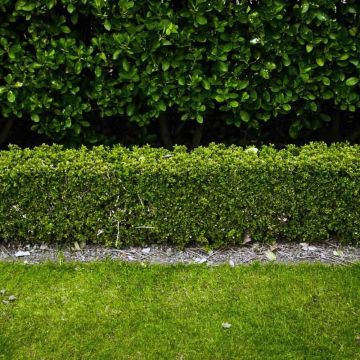
Buxus Box Hedging Buxus sempervirens
In stock
25% Off Instant Hedging and Pots 15L and Over. Use Code INSTANT25 at Checkout
Ends 05/06/25 23:59


2. Select Your Product Individual Plants
Choose between a range of sizes and select the quantity right for your job
Package Deals
Benefit from bulk buying with money saving product bundles
Root types explained.
-

Bare root
Field grown, bare roots are young plants that are only planted when they are dormant, from autumn to spring. We lift bare root plants and despatch them during the season but they can be pre-ordered in summer. As they are cheaper to grow, they are one of our most affordable hedge planting options.
-

Pot grown
Pot grown plants can be planted year round and make a convenient option. They come in a wide range of sizes, from 10cm to 2.5m so they're suitable for the majority of planting requirements.
-

Root ball
Also field grown, root ball plants are scooped out of the ground using machinery to keep their root system intact and wrapped in bio-degradable, hessian sacks. They are mature plants that provide dense coverage very early on, ideal for when you need a thick hedge quickly.
-

Instant
Grown in troughs or bags that measure 50cm-1 metre in length and carefully clipped during the growing season. Our instant hedging troughs create a dramatic, instant hedge effect.
Key Features
EVERGREEN
SLOW GROWING
HAS FLOWERS (Yellow)
FULL SHADE
Buxus sempervirens Hedge Plant Description
Popular for its small, oval-shaped glossy dark green leaves and naturally dense growth, the Box hedge (Buxus sempervirens) is a year-round evergreen that keeps gardens looking lush in every season. In spring, this slow-growing species produces tiny yellow-green flowers with a subtle, honey-like fragrance that attracts pollinators like bees. Its naturally bushy structure makes Box one of the best choices for adding shape to any outdoor space.
As a versatile and low-maintenance choice, Box hedging is perfect for trimming into neat borders, low hedges, and even intricate topiary designs. Its slow growth rate of around 10-15cm per year means it requires minimal upkeep, only needing an occasional prune to keep its shape. Box hedge plants are pollution-tolerant, making them well-suited to urban environments like town or city gardens. They thrive in most well-drained soils, and although they prefer full sun or partial shade, they can also tolerate some dappled shade.
Our bare root and root ball Box hedge plants are available from November to late April/early May, while instant hedging and pot-grown varieties are ready to go all year round for quicker results.* Learn more about which suits you with our hedging root type guide.
Need help figuring out how many plants to order? Our planting density guide has all the details.
Buxus is a well-loved hedging plant, but in certain areas of the UK, it can be extremely susceptible to Box Blight and Box Moth. If you’re looking for a similar low-maintenance, evergreen hedge, we recommend considering Japanese Holly (Ilex Crenata) or Euonymus 'Jean Hugues' as alternatives.
*Bare-root and root-ball stock are subject to availability and may change, but are generally available from autumn through to spring.
Vital Plant Information
Reviews
Plant Guarantee
Hedges Direct always supplies quality plants, however we know that sometimes plants have a mind of their own. With the Hedges Direct Green Guarantee, we've got you covered. Our 12-month guarantee is our 100% promise to you, that you can buy with complete confidence, that if any plants fail within 12 months, we will replace them when the guarantee conditions are met.
-
Step 1
Root Grow & Fertiliser
Ensure you buy root grow and fretiliser with your plants at the time of purchase
-
Step 2
Prepare Your Planting Area
Make sure your planting area is in good condition and suitable for planting
-
Step 3
Plant & Feed
Plant with root grow & the second feed. Support plants if necessary. Water regularly
Pruning Advice
Thanks to their slow-growing nature, most healthy Box hedging plants can be pruned once a year from late summer to early autumn to keep them looking neat throughout the winter. Just make sure that new growth has slowed to reduce the chances of leaf damage. New, young Box plants however, can be cut back buy up to a third in their first year to help encourage bushy new growth.
If you have an older Box plant, this species can tolerate a harder cut back in late spring when the last frost has passed. This is a good chance to reshape it and encourage thick, lush growth. Then, you can follow up with a light trim in autumn so it maintains its dense appearance throughout winter.
Want to know more? Head over to our Box hedging guide for more care and maintenance tips.
 Hedges Direct
Hedges Direct 







